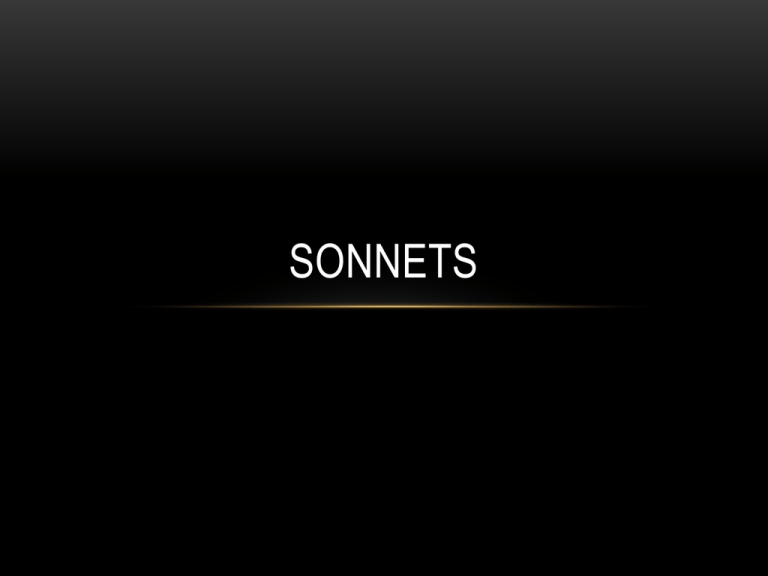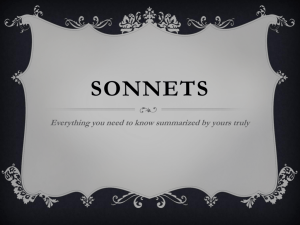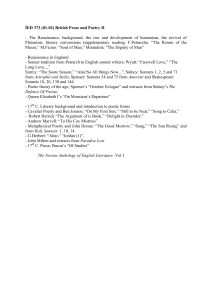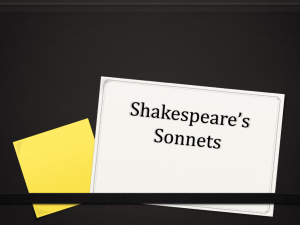Sonnets
advertisement

SONNETS CREATION/FEATURES • A sonnet is a form of poetry that originated in Europe, mainly Italy. • The term "sonnet" derives from the Italian word sonetto, meaning "little song" or "little sound". • By the thirteenth century, it signified a poem of fourteen lines in iambic pentameter that follows a strict rhyme scheme. A volta is often included to provide a shift in tone. • Sonnets have evolved over the years to include three different types: Italian/Petrarchan, Spenserian, and Shakespearean. ITALIAN SONNET • The structure of a typical Italian sonnet of this time included two parts that together formed a compact form of "argument." • The octave (two quatrains), forms the "proposition," which describes a "problem," followed by a sestet (two tercets), which proposes a resolution. • Typically, the ninth line creates what is called the "turn" or "volta," which signals the move from proposition to resolution. • a-b-b-a, a-b-b-a pattern became the standard for Italian sonnets. For the sestet there were two different possibilities: c-d-e-c-d-e and c-d-cc-d-c. In time, other variants on this rhyming scheme were introduced such as c-d-c-d-c-d. SONNETS COME TO ENGLAND • When English sonnets were introduced by Thomas Wyatt in the early 16th century, his sonnets (and those of his contemporary, the Earl of Surrey) were chiefly translations of existing Italian Sonnets. • While Wyatt introduced the sonnet into English, it was Surrey who gave it a rhyming meter, and a structural division into quatrains of a kind that now characterizes the typical English sonnet. • The form consists of fourteen lines structured as three quatrains and a couplet. • The third quatrain generally introduces an unexpected sharp thematic or imagistic "turn"; the volta. In Shakespeare's sonnets, however, the volta usually comes in the couplet, and usually summarizes the theme of the poem or introduces a fresh new look at the theme. WHOSO LIST TO HUNT • Whoso list to hunt, I know where is an hind, • Who list her hunt, I put him out of doubt, • As well as I may spend his time in vain. • And graven with diamonds in letters plain • There is written, her fair neck round about: • But as for me, hélas, I may no more. • The vain travail hath wearied me so sore, • I am of them that farthest cometh behind. • Yet may I by no means my wearied mind • Noli me tangere, for Caesar's I am, • Draw from the deer, but as she fleeth afore • And wild for to hold, though I seem tame. • Fainting I follow. I leave off therefore, • Sithens in a net I seek to hold the wind. SHAKESPEAREAN AND SPENSERIAN SONNETS • The Shakespearean sonnet is named after Shakespeare, not because he was the first to write in this form but because he became its most famous practitioner. • The usual rhyme scheme is: • a-b-a-b, c-d-c-d, e-f-e-f, g-g • A variant on the English form is the Spenserian sonnet, named after Edmund Spenser (c.1552–1599) in which the rhyme scheme is: • a-b-a-b, b-c-b-c, c-d-c-d, e-e.






